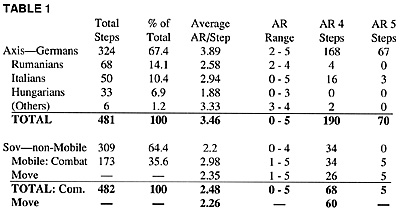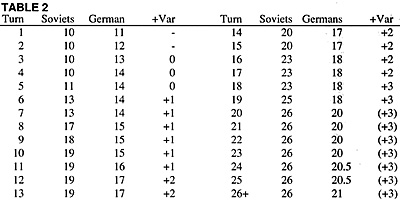Dean has written much on this topic, but he has given me permission to add to the current body of knowledge. Anyone who has played the game will attest to the limitless amount one could write about it. This is a big game-rich in flavor and vast in scope. Equally important, the Operational Combat Series rules version 2.0 (OCS v2.0) are a thorough improvement over the original. Tactics, gamey or simply mistaken, that worked before are now invalid, improper, or impotent. This game will take a long time to master, and may be beyond the capability of some players.
In this article I analyze the strengths and weaknesses of both sides, and how you can use these qualities to the best advantage. We have two (effectively five) different armies to analyze.
Numbers Crunching
I am not a number cruncher (and I don't wannabe ... where's the "Ice Man" when I need him'?). However, a quick "numerical analysis" of the armies follows, based on the average action ratings of attack capable units. Some of the strengths and weaknesses of' the Soviet and four Axis armies become apparent. This table is an approximation. I used the counters straight without consideration for breakdowns, alerts or units that begin in the dead pile, but it is close enough for government work. (Refer to TABLE 1.)

As you can see, the Soviets have improved from the days of Guderian's Blitzkrieg, but are still behind the Germans in overall quality. However, the addition of the Axis Allies definitely modifies the equation. Any portion of the Axis line held by an ally is an invitation to the Soviets to come out and play. As a quick note, the Italian average AR is deceptively poor. The Italians have no "2" and only two "1" AR steps. However, their seven Territorial Bns (AR "0") reduce their average.
Another consideration is force structure, specifically mobile (i.e. panzer/tank, mech, motorized, and cavalry) divisions/corps and the Soviet to German ratio. Again, this is an approximation for several reasons, including the variable German units and the differing quality of units. (Refer to TABLE 2.)

The table tries to reflect the average number of variable divisions that will be available. It is reasonable to expect that either none or all the variable divisions will show. The most apparent thing is that the Soviets never achieve a decisive preponderance of force on the battlefield. The Soviets do have an advantage in numbers of nondivisional mobile troops. However, the Germans make up much of their deficiency through quality. An important comparison is the loss of action rating for Soviet units in move mode.
The Soviet player will probably have a more difficult time his first few outings. There is a learning curve for the Soviet player. To help get over the hump of that curve, I will give the Soviet player tips first.
More Operational Notes for Enemy at the Gates
Back to Table of Contents -- Operations #14
Back to Operations List of Issues
Back to MagWeb Master List of Magazines
© Copyright 1994 by The Gamers.
This article appears in MagWeb (Magazine Web) on the Internet World Wide Web.
Other military history articles and gaming articles are available at http://www.magweb.com